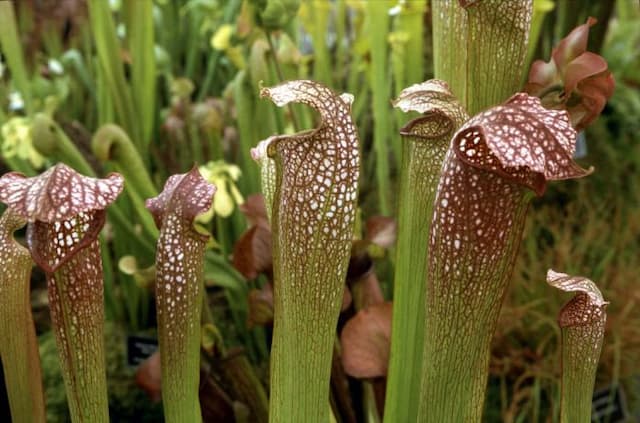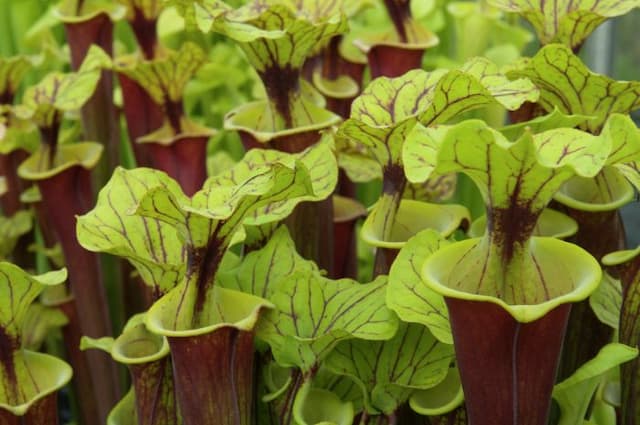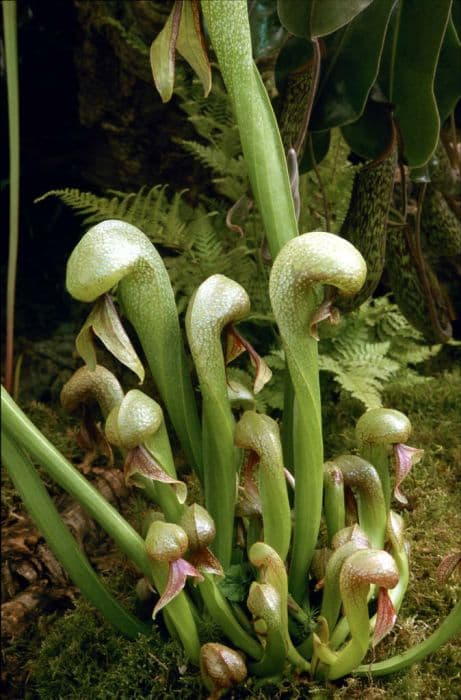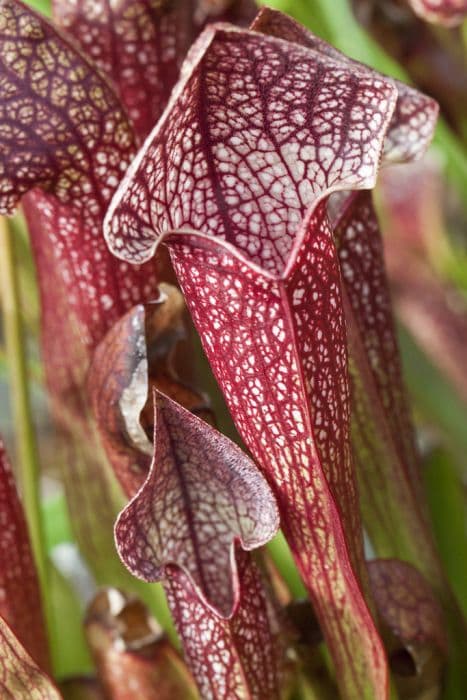Yellow pitcher plant Sarracenia flava var. maxima

ABOUT
The plant commonly known as the Yellow Pitcher Plant has a striking appearance that is both unique and captivating. It features tubular, pitcher-shaped leaves that are primarily a soft, green color. The inside of the pitcher is often adorned with a variable pattern of soft red to purple veins, which contrast beautifully against the green background. The pitchers have a smooth, waxy surface, which helps them to trap insects. This plant's most distinctive feature is its lid or "hood" that covers the opening of the pitcher, protecting it from rain and debris. The Yellow Pitcher Plant also produces flowers that are quite dramatic. The blooms stand tall above the foliage on individual stems and are a bright yellow hue, giving the plant its common name. Each flower has a sweet aroma and is umbrella-shaped, with many petals radiating out from a central point. The flowers add a burst of color to the plant's greenery, making it a vibrant and attractive spectacle when in bloom. As a carnivorous plant, the Yellow Pitcher Plant not only serves as a fascinating visual treat but also as a natural pest control agent, luring, trapping, and digesting insects to supplement its nutritional needs. This plant provides both aesthetic beauty and an intriguing example of nature's complexity.
About this plant
 Names
NamesFamily
Sarraceniaceae
Synonyms
Yellow Pitcher Plant, Trumpet Pitcher
Common names
Sarracenia flava var. maxima.
 Toxicity
ToxicityTo humans
The common name of Sarracenia flava var. maxima is Yellow pitcher plant. This plant is not generally considered toxic to humans. There are no significant symptoms of poisoning known for humans, as it is not commonly ingested and does not have a reputation for being harmful. However, as with any non-food plant, it is recommended to avoid ingesting it as the digestive system may not respond well to unusual plant matter.
To pets
The common name of Sarracenia flava var. maxima is Yellow pitcher plant. It is not known to be toxic to pets. While ingestion of the plant is not usually associated with serious health issues, it is always possible that a pet may experience mild gastrointestinal upset if they consume parts of the plant, including symptoms like vomiting or diarrhea. Such instances are more likely due to the novelty of the plant matter rather than specific toxicity. It is always best to prevent pets from ingesting plants not intended for consumption.
 Characteristics
CharacteristicsLife cycle
Perennials
Foliage type
Evergreen
Color of leaves
Green
Flower color
Yellow
Height
2 feet (0.61 meters)
Spread
1 foot (0.30 meters)
Plant type
Herb
Hardiness zones
6
Native area
Southeastern United States
Benefits
 General Benefits
General Benefits- Ecological Role: Sarracenia flava var. maxima, also known as the Yellow Pitcher Plant, serves as an important component of the ecosystems where it naturally occurs, often providing habitat and contributing to biodiversity.
- Insect Control: This carnivorous plant helps in controlling pest populations by capturing and digesting insects, which can be beneficial for nearby plants and human environments.
- Horticultural Interest: Due to its unusual appearance and carnivorous nature, the Yellow Pitcher Plant is a point of interest in gardens and amongst plant enthusiasts, adding aesthetic diversity and curiosity to plant collections.
- Education and Research: It can be used for educational purposes, providing a living example for lessons on adaptation, ecology, and plant biology, as well as for ongoing scientific research in these areas.
- Conservation Indicator: This plant can act as an indicator species for the health of the wetland habitats it occupies, which are often sensitive environments requiring conservation efforts.
 Medical Properties
Medical PropertiesThis plant is not used for medical purposes.
 Air-purifying Qualities
Air-purifying QualitiesThis plant is not specifically known for air purifying qualities.
 Other Uses
Other Uses- Sarracenia flava var. maxima, commonly referred to as the Yellow Pitcher Plant, can sometimes be used as a natural insect control method in gardens, as it attracts and traps many types of insects.
- The nectar of the Yellow Pitcher Plant may be collected and studied for its unique enzymes that can break down insect prey, potentially offering insights for biotechnological applications.
- Gardeners may use the Yellow Pitcher Plant in ornamental water gardens to add an exotic look, due to its striking appearance and carnivorous nature.
- During educational workshops, this plant species is often displayed to teach people about carnivorous plants and the diversity of survival strategies in the plant kingdom.
- Environmental artists may incorporate the Yellow Pitcher Plant into their installations to highlight issues of conservation and natural beauty.
- Photographers and filmmakers might feature the Yellow Pitcher Plant in documentaries or photographic series that explore the complexity of wetland ecosystems.
- The leaves of the Yellow Pitcher Plant are sometimes used in the craft of terrarium making, providing an unusual and eye-catching element to these miniature landscapes.
- Botanical illustrators and botanical art students might utilize the Yellow Pitcher Plant as a subject to understand and capture the intricate details of plant structures.
- Some chefs and mixologists use the dramatic appearance of the Yellow Pitcher Plant to garnish high-end dishes and drinks in a safe manner, after ensuring no toxic substances are in contact.
- Children’s books and educational materials sometimes include the Yellow Pitcher Plant to inspire an interest in botany and the natural world among young readers.
Interesting Facts
 Feng Shui
Feng ShuiThe Trumpet Pitcher Plant is not used in Feng Shui practice.
 Zodiac Sign Compitability
Zodiac Sign CompitabilityThe Trumpet Pitcher Plant is not used in astrology practice.
 Plant Symbolism
Plant Symbolism- Adaptation: Sarracenia flava var. maxima, commonly known as the Yellow Pitcher Plant, has adapted unique pitcher-shaped leaves to trap insects in nutrient-poor environments, symbolizing the ability to adapt and thrive under challenging circumstances.
- Patience: The plant’s mechanism of slowly digesting trapped insects over time represents patience and the idea that waiting can eventually lead to rewarding outcomes.
- Attraction and Deception: Its bright colors and nectar lure insects, symbolizing attraction and the duality of beauty, hinting at deception because of its carnivorous nature.
- Mystery and Uniqueness: As a carnivorous plant that’s quite unique in the plant kingdom, it embodies mystery and the allure of the unusual.
 Water
WaterThe Yellow Pitcher Plant should be watered regularly with distilled water, rainwater, or reverse osmosis water to mimic its natural boggy habitat. Keeping the soil consistently moist is crucial; hence, the plant should sit in about an inch of water during the growing season. Typically, you'll need to add water every 2-3 days, replenishing it as it evaporates, which equates to roughly 16-24 ounces per week during hot weather or less during cooler months. In winter, reduce the amount of water, making sure the soil doesn't completely dry out but is not as wet as in the summer.
 Light
LightThe Yellow Pitcher Plant thrives best in full sunlight conditions which promotes healthy growth and vibrant pitcher coloration. An ideal spot for this carnivorous plant would be outdoors in a sunny area or on a south-facing windowsill where it receives direct sunlight for most of the day. While it can tolerate some partial shade, especially in hotter climates, full sun ensures optimal development.
 Temperature
TemperatureThe ideal temperature range for the Yellow Pitcher Plant is between 70°F and 90°F during its growing season. These plants can withstand temperatures down to around 20°F but should not be exposed to freezing conditions for prolonged periods. During dormancy in the winter, cooler temperatures between 30°F and 50°F are beneficial for the plant's health and vigor.
 Pruning
PruningPruning the Yellow Pitcher Plant involves removing dead or dying pitchers and leaves to maintain plant health and appearance. It is best done in early spring before new growth begins. Typically, you should prune once a year, snipping off brown or damaged foliage to encourage new pitchers and leaves to form. Pruning also helps prevent rot and pest infestations.
 Cleaning
CleaningAs needed
 Soil
SoilThe best soil mix for the Yellow Pitcher Plant consists of a combination of sphagnum peat moss and perlite or sand in a 1:1 ratio, which ensures proper drainage and aeration. The soil pH should be acidic, ideally ranging between 4.0 and 5.0, to mimic its natural bog habitat conditions.
 Repotting
RepottingYellow Pitcher Plants should be repotted every 2 to 3 years to prevent soil compaction and to refresh the growing medium. Repotting is best done in early spring before new growth begins.
 Humidity & Misting
Humidity & MistingThe Yellow Pitcher Plant thrives in high humidity conditions, preferably between 60% and 80%. Consistently high humidity levels help in maintaining the health of the pitchers and promoting growth.
 Suitable locations
Suitable locationsIndoor
Provide full sunlight, keep the soil moist, and ensure humidity.
Outdoor
Place in full sun, use peat-based soil, keep moist.
Hardiness zone
6-8 USDA
 Life cycle
Life cycleSarracenia flava var. maxima, commonly known as the Yellow Pitcher Plant, begins its life cycle as a seed, usually requiring stratification, which involves exposure to cold temperatures to break dormancy. Upon germination in early spring, the seedling develops a small rosette of photosynthetic leaves and a rhizome underground. As the plant matures, it produces its characteristic tall, tube-like pitchers, which are modified leaves designed to trap and digest insects, enabling it to thrive in nutrient-poor environments. Throughout the growing season, the Yellow Pitcher Plant may flower, producing tall, nodding flowers of a pale yellow color, which are pollinated by insects. After pollination, seeds form and are dispersed in late summer or fall; the plant then enters dormancy as the pitchers die back and the rhizome stores energy for the next season. The perennial nature of Sarracenia flava var. maxima allows it to repeat this growth cycle for many years, emerging each spring with new pitchers from the energy stored in the rhizome.
 Propogation
PropogationPropogation time
Spring
Propogation: The most popular method for propagating the Yellow Pitcher Plant (Sarracenia flava var. maxima) is through division, which is best done in late winter or early spring before the plant emerges from dormancy. During this time, carefully unearth the plant and gently separate the rhizome into sections, ensuring that each division has at least one growth point. It is critical to use sharp, sterilized cutting tools to avoid damaging the plant or introducing disease. The divisions can then be replanted in a substrate designed for carnivorous plants, consisting of a mixture of peat and perlite or sand. After replanting, maintain high humidity and keep the soil moist but not waterlogged to encourage root development and plant recovery.









